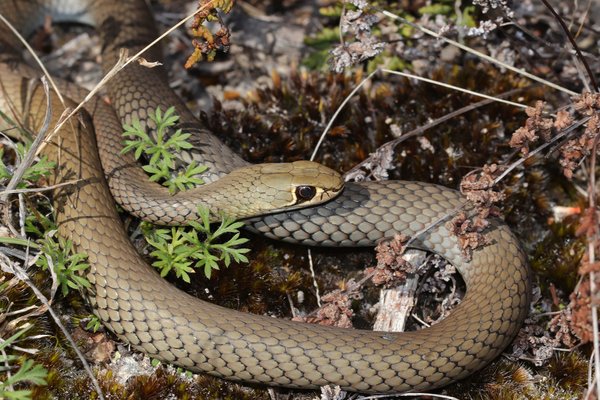Triage for Australia's lizards and snakes
Which of Australia’s endangered species need our most urgent attention? This was the question facing a group of conservation biologists, including two scientists from the Australian Museum Research Institute, following the most recent round of Red Data Book assessments of our reptiles.
Australia’s lizards and snakes often receive less attention in the public mind than more charismatic vertebrates such as marsupials, birds and frogs. There are many reasons for this, including the high proportion of species that are small, secretive, and (basically) brown, rather than highly coloured and conspicuous. Beige is not so beautiful in the public mind! Conservation assessment of the Australian lizard and snake fauna has likewise lagged behind the attention given to mammals and birds.

Conservation assessment of the Australian lizard and snake fauna has lagged behind the attention given to mammals and birds. This is the Cunningham's Skink (Egernia cunninghami).
Image: Stephen Mahony© Australian Museum
In 2017, as part of a world-wide IUCN assessment of the conservation status of reptiles, two workshops were held in Australia to assess the status our terrestrial reptiles, which was a total of nearly 1,000 species. As a result of these workshops, over 50 species of lizards and snakes were considered to fall under one of the various threatened categories, with two further lizard species endemic to Christmas Island already extinct in the wild and dependent on captive-breeding programs for survival. However, these IUCN categories alone do not provide a clear analysis of the relative risk of short-term extinction; this is a vital next step in determining which species most need attention to save them from being lost.
In an attempt to prioritise the risk of extinction facing threatened Australian lizards and snakes, a further assessment was carried out in 2019 by the Threatened Species Recovery Hub based at Charles Darwin University. For this new study, published this week, 26 experts from the 2017 workshops provided risk assessments for the original list of species, in addition to another 9 species newly recognised since 2017 that fitted the IUCN criteria. Among the experts were two scientists from the Australian Museum Research Institute: Dr Hal Cogger and Dr Glenn Shea.

The holotype of the Bathurst Earless Dragon (Tympanocryptis mccartneyi) at the Australian Museum is one of only three specimens available to study the species.
Image: Stephen Mahony© Australian Museum
Ten of the 60 species studied were found to have a high (>50%) risk of extinction within the next two decades without significant conservation management, and the two Christmas Island species that were already dependent on captive breeding were considered unlikely to survive reintroduction attempts. Most of the species at highest risk were either from Christmas Island or Eastern Australia, and all had very small distributions, with areas of occupancy of less than 56 km2. Several species are restricted to single localities. Habitat change and invasive species (both weeds that change the habitat and increase the fire risk, and animals that either modify habitat by trampling or directly predate on reptiles) were found to be the major threats.
Interestingly, while many of the species in the highest IUCN threat categories (Critically Endangered and Endangered) featured on our “Red Hot List”, not all of them did, and some of our red hot top 20 were not in the highest IUCN categories, highlighting the difference between IUCN categorisation and determining which species need immediate action.

The Limbless Fine-Lined Slider (Lerista ameles), a burrowing skink, is one of the red hot top 20.
Image: Ross Sadlier© Australian Museum
While only one Australian reptile is known to have become extinct in the past century, the Christmas Island Forest Skink, Emoia nativitatus, two of our top 20 species may soon be about to join it, if they aren’t already lost. The Grassland Earless Dragon, Tympanocryptis pinguicolla, endemic to grasslands of the basalt plains near Melbourne, has not been seen for about 50 years, and the recently named Bathurst Earless Dragon, Tympanocryptis mccartneyi, likewise a grassland inhabitant, has not been seen for nearly three decades.
Our ranking assessment on these and the other red hot species allows government agencies and conservation bodies to further prioritise their efforts to save Australia’s precious reptile fauna.
Dr Glenn Shea, Senior Lecturer in Veterinary Anatomy, University of Sydney; and Research Associate, Australian Museum Research Institute
More information
Geyle, H. M., Tingley R., Amey A. P., Cogger H., Couper P.k J., Cowan M., Craig M. D., Doughty P., Driscoll D. A., Ellis R. J., Emery J-P., Fenner A., Gardner M. G., Garnett S. T., Gillespie G.e R., Greenlees M. J., Hoskin C. J., Keogh J. S., Lloyd R., Melville J., McDonald P. J., Michael D. R., Mitchell N. J., Sanderson C., Shea G. M., Sumner J., Wapstra E., Woinarski J. C. Z., Chapple D. G. (2020) Reptiles on the brink: identifying the Australian terrestrial snake and lizard species most at risk of extinction. Pacific Conservation Biology, https://doi.org/10.1071/PC20033











